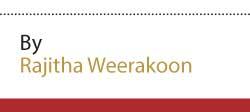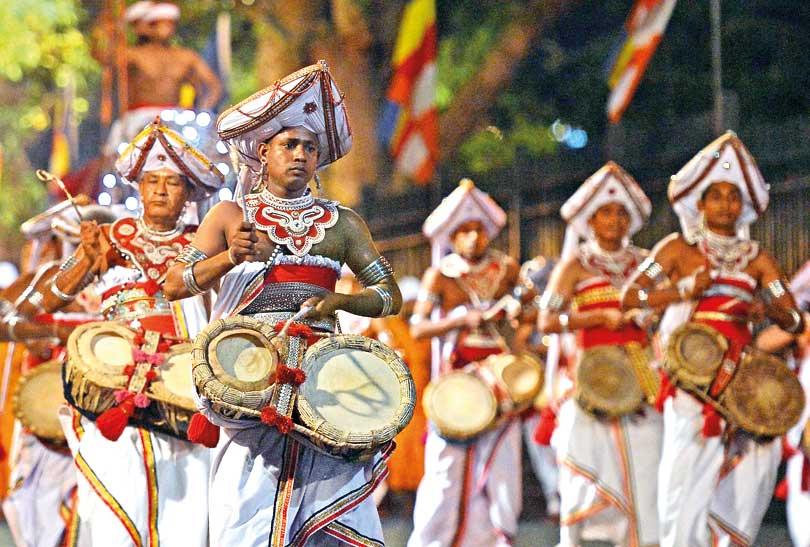14 Aug 2019 - {{hitsCtrl.values.hits}}

 Kandy Esala Perahera (Kandy pageant), which is now winding through the streets of Kandy in all its splendour, is yet to be acknowledged as a pageant one of its kind. Despite its historic significance, cultural diversity along with pomp and glory, international recognition for it has so far been illusive.
Kandy Esala Perahera (Kandy pageant), which is now winding through the streets of Kandy in all its splendour, is yet to be acknowledged as a pageant one of its kind. Despite its historic significance, cultural diversity along with pomp and glory, international recognition for it has so far been illusive.
Having read Dr. Lorna Dewaraja’s “Kandy Asela Maha Perahera,” written and completed just a few months before her demise, we find all the reasons to pursue the objective of world recognition. Her in-depth study of the 1700-year-old history of the pageant -that grew through internal conflicts and external invasions and survived as a veneration to the Sacred Tooth Relic- stimulates one’s thoughts and inspires to pursue this worthy objective.
Dr. Dewaraja who had dug deep into history, relates the commencement of veneration of the Tooth Relic by a king and a grateful nation overwhelmed by its arrival in Sri Lanka. Brought in the ninth year of the reign of Kithsiri Megavanna (301-328CE) who was the son of the King Mahasen, the impact of it was seen by the fact that at least two literary works were written on the arrival of the Tooth Relic. Dhathuvamsa written in Pali in the Polonnaruwa Period mentions that the work was based on the earlier Daladavamsaya. Daladavamsa now not in existence, was written in Sinhala in the same year the Tooth Relic was brought to Sri Lanka by Prince Danta and Princess Hemamala from the kingdom of Kalinga. The author of Daladavamsaya thus, may have had the privilege to have received information surrounding the bringing of the Tooth Relic directly by the Royal duo.
The annual festival of the Tooth Relic had commenced as a procession from the Abhayagiri Viharaya which was receiving royal patronage at the time. It was therefore, entrusted to attend to the Sacred Relic. However, Abhayagiri Viharaya being the main centre of the Mahayana sector, and it being more liberal in its outlook, this first procession with the Mahayana influence may have been a colourful and lively pageant.
A vivid description of the earliest years of the Dalada Perahera is given in the records of Fa Hien, the Chinese pilgrim who visited Sri Lanka during the reign of Mahanama (410-432CE.) He wrote “they always bring out the Tooth Relic in the middle of the third month (of the Buddha Varsha so it should be July-August.) Ten days before the event, the king caparisons beautifully a great elephant and commissions a man of eloquence to cloth himself in royal apparel and ride the elephant. He was asked to sound a drum and make proclamations on the life of the Bodhisathwa (which shows Mahayana influence even hundred years after the arrival of the Relic) and the Teachings of the Buddha.
“Ten days after the commencement of the pageant, the Tooth Relic was brought back to the Abhayagiri Viharaya and placed in the Hall of the Buddha where the clergy and the devotees conducted religious ceremonies night and day. On completing ninety days, the Tooth Relic was returned to the Vihara which housed the relic.
The annual festival of the Tooth Relic had commenced as a procession from the Abhayagiri Viharaya which was receiving royal patronage at the time
Taking into account Fa Hien’s visit during the reign of Mahanama, Dr. Dewaraja has stated, there has been a cult associated with the Tooth Relic in China. This had strengthened Sino-Lankan relations. This is confirmed by those employed at the embassies taking into consideration the period falling between 425 and 434 CE.

Festivities are mentioned once again in Culavamsa where it is mentioned that Anuradhapura rulers such as Dhatusena (455-473CE,) Aggrabodhi 1 (571-604CE) and Sena 11 (853-887CE) had shown great devotion to the Relic and held glittering festivals in veneration of these remains of the enlighten one.
With the shift of the Capital to Polonnaruwa, Vijayabahu (1055-1110CE,) following the liberation of the country from the Colas, a beautiful temple called the Tooth Relic was created. “The Instituting permanently” of a great festival was then done. The festival however, became more pronounced as a procession during the reign of Parakramabahu 1V (1302-1326CE) who ruled from Kurunegala. Resembling the present pageant the Tooth Relic was taken round the Capital exhibiting it to the public. Special offerings were made to the Relic prior to the parade with the King, dignitaries of the state and the citizens in attendance. On the seventh day of the festivities, the Relic is brought out and paraded.
However, unlike now, the relic casket was not placed on a caparisoned elephant, but in an ornamental chariot which was yoked to a decorated elephant. In front of the chariot walked the Sangha each one holding a string of protection tied to the chariot while sacred water is sprinkled on the streets. Officials of the Temple, palace officials and an Army detachment followed the Sangha travel in the prossession. It had been with such protection that the casket had been opened and the Relic exhibited.
Culavamsa has recorded that Parakramabahu V1 (1412-1467) built a splendid three storeyed mansion in Kotte to house the Tooth Relic near his palace. But there is no mention of a procession during this period. Following his death, and the subsequent internal chaotic situation in the country and foreign invasions, the Tooth Relic was taken away by monks and hidden in a grinding stone in Delgama Viharaya in the South.
Two and a half centuries later, with Vimaladharmasuriya 1 (1592-1604,) establishing the Kandyan kingdom, the relic was brought back to the capital known then as Senkadagala Pura and placed in a two-storeyed Relic House adjacent to the Palace. And Vimaladharmasuriya 11, the son of Rajasinghe 11, built a three-storeyed palace and a golden reliquary studded with precious stones to place the Tooth Relic after holding a sacrificial festival.

No mention however is made of a Perahera during these early years of the Kandyan Kingdom until Robert Knox (1660-1679,) British prisoner during the reign of Rajasinghe 11(1635-1687CE) gives an extensive description of the Kandy Pageant which had paraded the Kandy roads. It however, had not included the Dalada Perahera. With constant foreign incursions during this period, Dr. Dewaraja has suggested that monks may have taken away the Relic and hidden in a secure place? Also, with marriages of Kandy kings to Nayakkara princesses, the influence of Hinduism became much evident.
It was during the reign of Sri Vira Parakrama Narendrasinghe (1707-1739CE,) , the last Sinhala king of Kandy, that the Esala Pageant was amalgamated in the Festival which up to then had only the processions of the Aluthnuwara, Kataragama and the Pattini Devalas. He directed that the Kany Esala Pageant be given the foremost place.
19 Apr 2024 19 minute ago
19 Apr 2024 47 minute ago
19 Apr 2024 1 hours ago
19 Apr 2024 1 hours ago
19 Apr 2024 3 hours ago